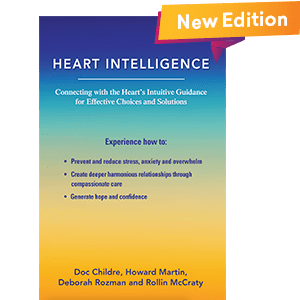Excerpted from Heart Intelligence: Connecting with the Heart’s Intuitive Guidance for Effective Choices and Solutions
CHAPTER 9 COMPASSION: THE NEED OF THE TIMES
Written by Doc Childre and read by Deborah Rozman.
Download Audiobook Chapter

Download the mp3 audio file of Chapter 9 from the new edition of Heart Intelligence: Connecting with the Heart’s Intuitive Guidance for Effective Choices and Solutions. Written by Doc Childre and Read by Deborah Rozman.
Compassion increases in effectiveness as we mature in practicing the core qualities of the heart, such as unconditional love, allowance, acceptance, and an unattached desire for the highest outcome for all concerned. Cultivating these heart qualities strengthens our compassion and frees it to serve the highest best. True compassion benefits the sender and receiver, though we can’t always see the ways it nurtures and heals or makes it easier to adjust to tougher situations we experience.
Often when small kids are distressed, unhappy, or experiencing a tantrum, we instinctively redirect their energy by giving them a toy or loving attention, and almost instantly they can totally change their frequency pitch (vibration) to calmness, joy, elation, or contentment (higher pitch emotions). A primary reason that young children often transform compressive emotions quickly is because in their early years of development they are still connected to the higher frequencies of their natural heart attributes, such as uncomplicated love, transparency, lack of prejudice, and their superpower to release and move on. Their minds are not yet entrained to the countless lower vibration societal mindsets and habits that often overshadow their heart’s higher feelings and choices.
Many of us have felt drained and stressed on occasion from what we thought was giving compassion. This energy drain and depletion can be triggered especially from unbalanced empathetic care. Empathy can produce strong feelings of care but often comes with tentacles that create over-attachment to what we care about.
Download Audiobook Chapter

Download the mp3 audio file of Chapter 9 from the new edition of Heart Intelligence: Connecting with the Heart’s Intuitive Guidance for Effective Choices and Solutions. Written by Doc Childre and Read by Deborah Rozman.
Compassion is one of the highest supportive energies of love. I used to think it was for fixing others. We can support each other with our love and compassion, but people have to do their own fixing from within. I was a dedicated “Mr. Fix-all” until I learned that people have to make their own adjustments or else challenges keep repeating—sometimes in different arrangements, and sometimes in much harder circumstances. Often the problems we rush to fix for others are their growth opportunities for learning to connect more deeply within their own heart and soul for direction and solutions.
Learning to balance our empathetic interactions is a big step towards understanding the tone of true compassion. Compassion is an unconditional love that supports the highest outcome for others without depleting our personal reservoir of energy. Whereas unmanaged empathy, sympathetic attachment, and “tired-care” are the rocks to look behind when we feel drained from extending what we felt was our heart’s compassion. One reason that compassion is misunderstood is that for ages, people have used the term “compassion” as a convenient cover-all word for what is often sympathy, empathy, pity, or excessive worry. More people are being prompted from within to gain a deeper understanding of compassion, since compassion tops the list of what would benefit humanity most in these transitional times. Compassion is a powerful core frequency within our heart, but in most cases it takes practice to feel love and care for people in extreme stress without becoming overly-identified with their challenges (a learning curve for all of us). One expression of true compassion is when we can hold love and light for others in dark moments, without draining our own battery and joining them in the dark.
More about Empathy
Since compassion is so often confused with empathy, I feel it could be helpful to restate a few points that set these two expressions of care apart. As mentioned earlier, sensitivity to other’s pain points often triggers feelings of compassion and empathetic care; however, the effectiveness of our care diminishes rapidly when we over-attach mentally and emotionally to their issues. Empathy can sense the suffering of others yet can be managed to maintain balance and energetic composure within its care.
News stories, children’s challenges, other people’s health issues, etc. can elicit our empathetic responses which, without management, can trigger a continuous drain throughout our whole system even if we feel like we are “kind of in charge.” Empathy starts out as an asset, yet it can become a source of misery if we don’t find our balance with it. A reality moment is when we realize (not just intellectually, but really get it) that unmanaged empathy can produce continuous energy deficits that far outweigh the “good” we think we are providing to others. Unnecessary aging comes with this quandary.
The following is a standard outcome that most of us have read about or experienced from unmanaged empathy:
On the edge of burnout, we end up livid with ourselves for sinking too deep into others’ challenges, or the world’s problems, and then we get angry because there’s nobody to blame but ourselves (though we give it a good try). It gets worse as we remember that we learned our lesson the last time this happened—and here we are again. This is often followed by self-judgment and self-reduction until we get too worn down to even do that. Then we stressfully regather ourselves over a period of time and start all over with new self-care commitments, feeling like we’ve really learned our lesson this time….
We can change the ending to these stories of self- generated ambushes by paying more attention to intuitive feelings that signal us when our empathetic care becomes unbalanced from over-attachment and self-depletion. Our heart’s intuitive feelings often provide warnings before self-depletion sets in, but we can often fall short on taking action because we think over-emotional identity to what we care about is justified. At times our mind is good at diverting us from our heart’s wiser suggestions.
Like many others, my heart intuition was blocked by my mind’s misinterpretation of empathy. I thought living on the edge of burnout from serving others was virtuous and noble. I felt it was proof of my self-sacrifice “to share the light and spread the good” like a little knight. (Picture a knight in shining ignorance on a mission to fix everyone, whatever the personal cost—that was me at age twenty five.) Much of that experience was from young-buck ego vanity, mixed with sincere, yet unbalanced empathetic care. I’ve moved on since then after learning the same lesson, repeatedly. But I still closely monitor the difference between empathy and balanced care. It stays high on my personal list of self-care maintenance practices.
Remember, empathy itself is not the source of energy drains; it’s the unintentional mishandling of empathy that drains and taxes our well-being. Our hearts have the capacity to maintain energetic detachment and emotional equability, but this requires a little genuine practice to instate. It’s one of the most valuable gifts we can give ourselves. Balanced empathy can nurture and serve others without serving us up with it. Learning the difference between lower empathetic attachment and balanced care can help dissolve most of the problems around empathy—and help us mature in the understanding of true compassion and its effectiveness. This practice may be helpful in balancing empathy:
Practice watching some recorded movie scenes where the characters are experiencing a medium amount of physical or emotional pain that creates a challenging sympathetic or empathetic feeling in you. As you watch, breathe in a relaxed way and practice detaching yourself from the emotional over-identification.
If you do this enough times you will eventually find a place within yourself where you can regulate your feelings. You will start to realize that you can actually genuinely care about what is going on without it pulling you into it.
The advantage of watching the scenes several times in a row is that it gives you more chances to experiment with finding that inner switch which regulates your emotional output. Practicing with movie scenes gives you a jump start on learning dispassion and intentional composure, which help with learning true compassion. These types of practices are often used by first responders to learn to maintain emotional composure as they respond to car wrecks, catastrophes, and such. This skill can be developed. Know in your heart that maintaining your emotional composure, without suffering with people in distress, doesn’t mean that you care less for them. Your care and compassion are actually more effective.
Compassionate Latitude
Compassionate latitude is a heart quality that realizes most people are doing the best they can based on their stress overload, anxiety, and the strained thinking so many are experiencing these days. Latitude is the consideration and understanding that we all fall short at times in our choices, words, or actions, especially when enduring stress from challenges that others aren’t aware of. Compassionate latitude increases patience and encourages a deeper understanding of another’s situation.
Practicing compassionate latitude with each other quickly begins to reduce and prevent stress build-up from stored anger, judgments, and resentments. This is so important for maintaining balance and resilience during pressing times of change and unpredictability. It’s time to skip the drama, reduce judgments and resentments, and move on. Here’s an exercise that can help.
Compassionate Latitude Exercise
- Start with quiet breathing while radiating feelings of care for someone or something you appreciate. This helps to shift your energy from the mind to your heart.
- Next, ponder situations where you could give others more compassionate latitude (e.g. at home, at work, and especially while sorting out miscommu- nications, etc.)
- As you breathe, imagine yourself reducing judgments, infuriated responses, and lack of tolerance with compassionate latitude (e.g. attitudes of deeper care, kindness, patience, understanding, and tolerance). Practicing several days in a row helps to anchor this valuable habit.
Another helpful exercise is each day find situations where you can replace judgments and reactions with compassionate latitude.
More on Self-Compassion
Self-compassion is an advanced step in anyone’s personal empowerment and self-care practices. At first people tend to respond awkwardly when it’s suggested they feel compassion for themselves—it can seem a little self-serving, out of place, undeserved, unspiritual, etc. These attitudes come from handed-down entrainment from old belief systems that don’t serve us anymore. Self-compassion has been on the back burner too long, and now it’s time to seize the moment and take advantage of its transformational benefits. To have compassion for yourself is not an act of selfishness; it’s an act of intelligence, heart intelligence.
Don’t confuse self-compassion with pity-party-type emotions; it’s a transformative vibration from our heart that nurtures us with nonjudgmental acceptance and a deeper understanding of our self. Practicing this form of self-care is especially helpful when transitioning through situations that require time for healing and emotional adjustment. If we have physical or emotional challenges, self-compassion intuitively guides and supports us through the best ways to handle our issues or situations. However, self-compassion is not just for challenging times as it could seem. It’s a regenerative energy that serves as a tonic for our cells and our operating system.
Self-compassion is a higher-vibrational frequency sourced from the love and power of our heart and spirit. We obviously think compassion is beneficial or else we wouldn’t automatically gush it out to others, pets, or suffering around the world, etc. Why wouldn’t we do this for ourselves? See self-compassion as a powerful self-maintenance type of care. This process gets easier once you understand it is just another self-care practice, like putting salve on a sore arm. Here’s an exercise you can try:
Self-Compassion Exercise
- To Practice Self-compassion,simply get quiet somewhere and imagine creating an inner spa.
- Imagine breathing self-compassion and positive energy into your mental/emotional nature and into your physical cells. Most importantly, do this from the heart as it connects directly with the healing and renewing qualities from your spirit.
Self-compassion takes a little practice, but today’s transitional times call for these types of practices because of compassion’s restorative benefits to our mental, emotional, and physical nature.
……………….
Compassion is a most powerful and intelligent frequency within the love spectrum. As we unconditionally express compassion, it intuitively chooses its own way to administer its care based on a sensitive attunement to the higher need of the whole. Pure compassion is not tethered to our agendas; it’s free to weave its magic, sometimes visibly yet often unseen, but never wasted as it nurtures all within its radiance. True compassion supports the highest-best outcome, which is not always what our personality would choose or understand. Unconditional love sets the tone for true compassion. As our human intelligence spirals to the next station of enlightenment,
then collective compassion will become the foundational vibration for amplifying the connection with our soul and source as they stream love and healing through our human experience. Compassion is transformational love and care manifesting in the most ripened state of effectiveness for the whole.
– Doc Childre

